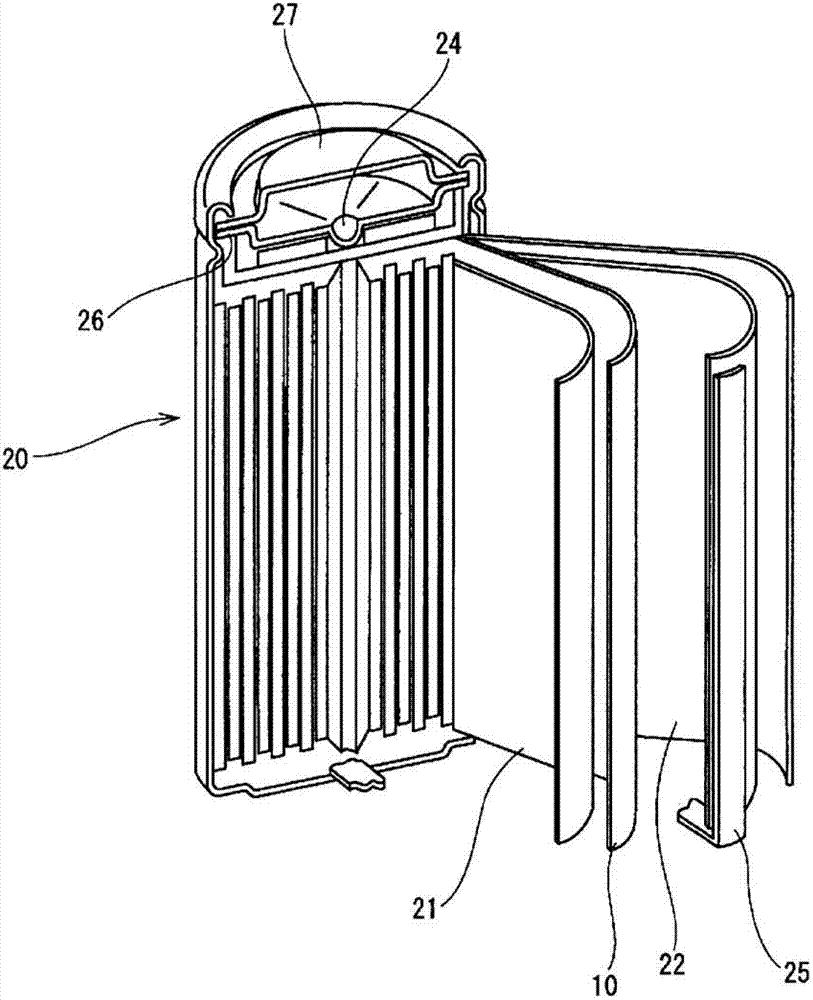Porous polypropylene resin film, cell separator, and cell
A technology of polypropylene and porous membranes, applied in the field of porous membranes, can solve problems such as not being able to be used as an electrolyte, and achieve excellent sliding properties
- Summary
- Abstract
- Description
- Claims
- Application Information
AI Technical Summary
Problems solved by technology
Method used
Image
Examples
Embodiment 1
[0251] With respect to 100 parts by mass of polypropylene-based resin (manufactured by Prime Polymer, Prime Polypro F300SV, MFR: 3 g / 10 min), 0.2 part by weight of antioxidant (manufactured by Ciba Specialty Chemicals, IRGANOX B225) and nucleated as beta crystals were added 0.2 parts by mass of N,N'-dicyclohexyl-2,6-naphthalenediamide as an agent, using a co-rotating twin-screw extruder (diameter φ40mm, L / D=32) manufactured by Toshiba Machine Co., Ltd. at 270°C It melt-kneaded, it processed into pellet form, and obtained resin composition A1.
[0252] The resin composition A1 was extruded at 200°C, cooled and solidified by a casting roll at 130°C, and a nonporous film having a thickness of 80 μm was produced. The above-mentioned non-porous film was subjected to sequential biaxial stretching by stretching 4 times in the longitudinal direction at 105° C., and then stretching 2 times in the transverse direction at 145° C., and then relaxing the film by 6% in the width direction a...
Embodiment 2
[0255]Different from the above-mentioned resin composition A1, high-density polyethylene (manufactured by Prime Polymer Co., Ltd., Hi-ZEX3300F, density: 0.950 g / cm) was used as a polyethylene-based resin. 3 , MFR: 1.1g / 10 minutes) 90 parts by mass of microcrystalline wax (manufactured by Nippon Seiki Co., Ltd., Hi-Mic1090) 10 parts by mass and polyethylene-based masterbatch containing a nucleating agent (manufactured by Riken Vitamin Co., Ltd.) , RIKEMASTER CN-002) 2.5 parts by weight, and use the same type of co-rotating twin-screw extruder to melt and knead at 230 ° C, and then process it into pellets to obtain resin composition B1.
[0256] Resin compositions A1 and B1 were extruded using different extruders at 200°C, passed through two three-layer feedblocks, co-extruded using a T-die for multi-layer molding, and were drawn so that After stretching, the film thickness ratio was A1 / B1 / A1=3.5 / 1 / 3.5, and it was laminated, and then cooled and solidified by a casting roll at 12...
Embodiment 3
[0260] The above-mentioned resin compositions A1 and B1 were extruded at 200°C using different extruders, passed through two three-layer feedblocks, co-extruded using a T-die for multilayer molding, and were After stretching, the film thickness ratio was A1 / B1 / A1=3.5 / 1 / 3.5, and the lamination was carried out. Then, it was cooled and solidified by a casting roll at 127°C, and a laminated non-porous film with a thickness of 80 μm was produced. thing.
[0261] The above-mentioned laminated non-porous film was subjected to sequential biaxial stretching by stretching 4.6 times in the longitudinal direction at 120°C, and then stretching 2 times in the transverse direction at 98°C, and then relaxing the film in the width direction at 115°C for 6 times. %, a laminated porous membrane was obtained.
[0262] Various properties of the obtained laminated porous film were measured and evaluated, and the results are summarized in Table 1.
PUM
| Property | Measurement | Unit |
|---|---|---|
| thickness | aaaaa | aaaaa |
| density | aaaaa | aaaaa |
| melting point | aaaaa | aaaaa |
Abstract
Description
Claims
Application Information
 Login to View More
Login to View More - Generate Ideas
- Intellectual Property
- Life Sciences
- Materials
- Tech Scout
- Unparalleled Data Quality
- Higher Quality Content
- 60% Fewer Hallucinations
Browse by: Latest US Patents, China's latest patents, Technical Efficacy Thesaurus, Application Domain, Technology Topic, Popular Technical Reports.
© 2025 PatSnap. All rights reserved.Legal|Privacy policy|Modern Slavery Act Transparency Statement|Sitemap|About US| Contact US: help@patsnap.com



